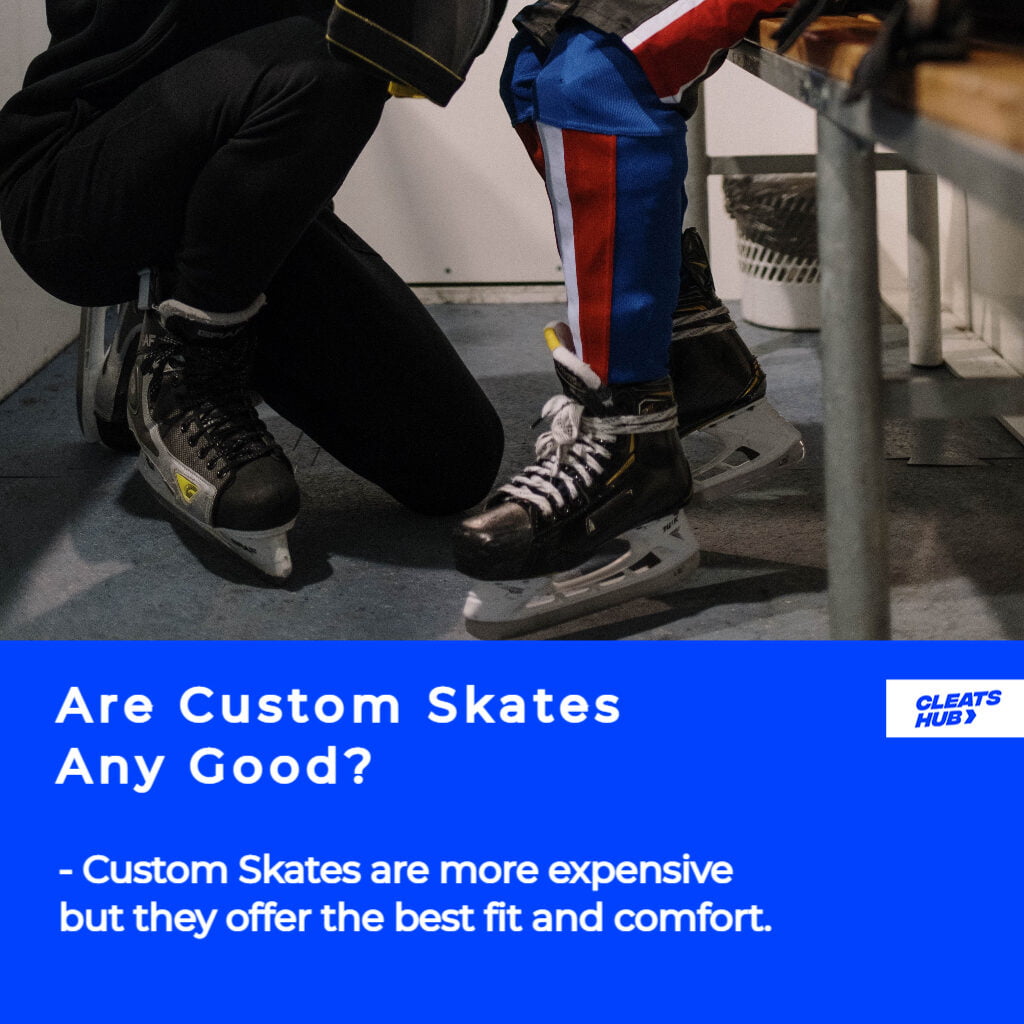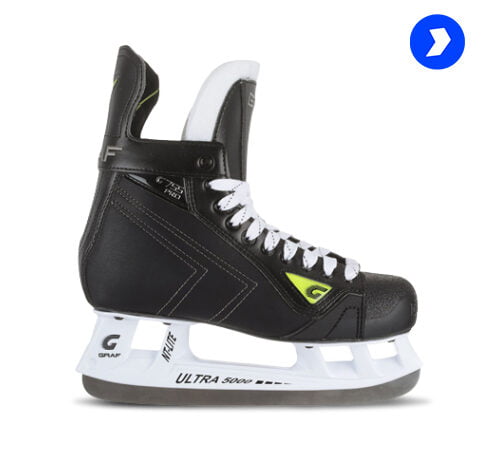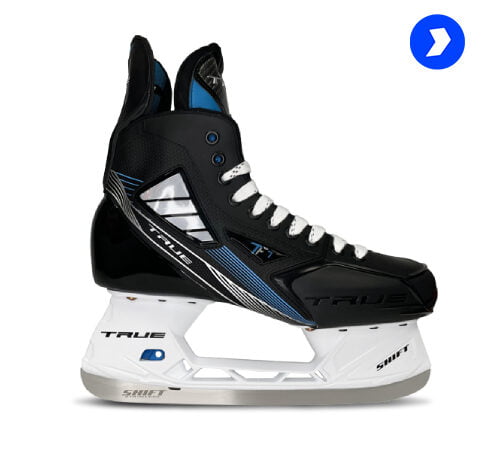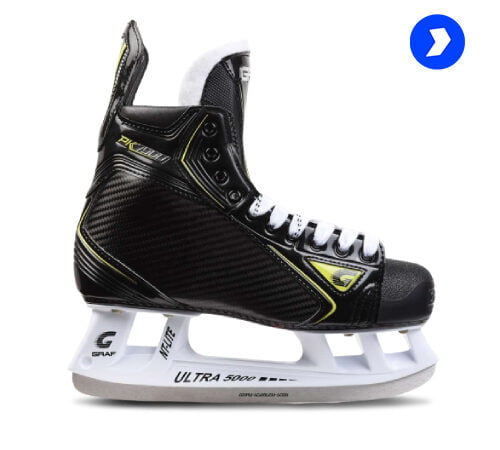Why are Ice Hockey Skates so Uncomfortable?
During skating, ice hockey skates provide the feet with stability, support, and protection. Nonetheless, they may cause discomfort and agony.
New skates or skates that have not been broken in hockey are usually unpleasant. Also, if the hockey skates do not fit properly or the laces are tied too tightly, they could be unpleasant.
What Factors Determine Your Ice Hockey Skate Comfort Level?
Hockey Skate Toe Space
Ideally, your toes should barely touch the toe cap when you insert your foot inside the skate without the skates being laced up. This is because they will be pulled back just enough so that they won’t brush the inside of the toe cap when you are completely laced up and standing. Your heel will then rest farther back in the heel pocket. Your skates can first be too small when you wear them, but after standing up, they become a perfect fit!
Properly Fitted Skates
Beyond name, style, or look, the fit is the most important consideration when purchasing skates. Your skates must fit properly if you wish to skate to the best of your ability. What then ensures a skate fits snugly? The size and boot style should be taken into account when determining skate fit.
1. Size
Despite what it may seem like, skaters occasionally get the wrong skate since they should usually purchase a smaller skate than they would ordinary shoes. However, bear in mind that wearing the right size skate will improve your performance by making you feel safe and at ease when skating.
Too Big: Skates can cause your foot to move inward, slowing you down. The chance of being wounded and getting blisters rises when you wear skates with excess foot space. In addition, wearing skates is probably not going to be very comfortable for you.
Too Small: If the skates are too small, they may cause your feet to cramp, and they will be uncomfortable and tight. This, in turn, will impair your ability to skate quickly and correctly.
2. Boot Construction
The boot construction is important when choosing your skates for a number of reasons. The makers of various kinds of skates cater to the majority of foot shapes. These days, businesses provide broad, deep skates in one design and somewhat different, lower-volume skates in another.
By taking your time, you may choose the skate that fits your foot the best (and even try on a few other brands and models). Certain brands even offer variations between those.
Pro Tip: If your foot is wide, you should pick a skate model made specifically for broad feet. Try to resist the urge to wear or support the brands of your favorite athlete if it doesn’t suit your foot!

How To Find The Perfect Fit
The goal is to get a skate that can fit your foot in three separate places. You should consider:
- how wide the forefoot is
- the heel’s thickness
- overall volume.
Note: The size of the skate has less bearing on volume than the dimensions of the boot.
When shopping for skates that will match your foot profile, it is a good idea to determine the type of foot you have. This is advised because manufacturers provide so many different varieties.
Hockey Skate Width
You must know your width ratio once you’ve decided what size skate you require. You may determine your foot’s breadth and depth using the width ratio. When you divide the length of your foot by its breadth, you get your width ratio.
This helps you determine how big and long your feet are compared to one another. The following gives a broad sense of how width ratio and skate size relate:
Traditional: Width ratio of less than 2.5
- Forefoot: Wide
- Heel: Deep
- Volume: High
Contoured: Width ratio between 2.5 – 3.0
- Forefoot: Standard
- Heel: Standard
- Volume: Medium
Tapered: Width ratio greater than 3.0
- Forefoot: Narrow Or Slightly Narrow
- Heel: Shallow/Narrow
- Volume: Low
Forefoot
You’ll have a comfy skate if you get one that fits your forefoot width. The forefoot should provide the proper grip without being overly tight. If your feet are naturally broad, you’ll probably require a classic skate with a wider forefoot.
In terms of the forefoot, the width ratio operates in the other way; the lower your ratio, the bigger the forefoot you’ll require.
Heel
The heel of a hockey skate is connected to the depth area of the skate boot. There are deep, standard, and thin kinds of heels. To keep the back of your foot in place, make sure your heel is “locked” into the boot.
As your heel shouldn’t be able to slip at all, make sure to try on models designed for the type of heel you have.
Volume
The volume when referring to hockey skates is not the size of the skate overall but rather the size of the boot. A low-volume skate is best if your feet are smaller, but a high-volume skate is required if your feet are wider.
If your foot is naturally wide, try on a skate with a standard fit. Try on a boot made for a thin, tapered foot if you have larger, broader feet instead.
How To Make Your Ice Hockey Skates More Comfortable
Hockey games may be substantially enhanced by using cozy skates. The perfect fit may be achieved by baking and placing insertings into hockey skates. It’s also a wonderful idea to have custom skates made.
You may also go above to increase their comfort and functionality if they are the right length and width. The following advice can help you make your ice hockey skates more comfortable:
Ice Hockey Skates Inserts and Gel Pads
Plastic inserts are an excellent way to help stop the irritating and perhaps paralyzing lace biting. Under the laces, they often provide extra ankle and instep comfort and fit into the tongue’s groove.
Lace bite gel pads are a different manual treatment that many skaters find useful. When these pads are applied, the soft gel rests on your skin or the underside of your skate tongue. An additional popular design is elastic ankle sleeves with integrated gel cushions.
You can also correctly knot your shoelaces. Adjust your skate laces if necessary, but this time, lace them back up through the eyelets from the outside. This allows the laces to better follow the shape of the tongue, reducing strain.
Skate Insoles
Orthotics for hockey skates come in a variety of designs and are a practical way to improve the fit and comfort of your skates. If the factory insoles don’t provide the support or comfort you’re searching for, custom insoles are an easy fix.
Insoles are either plusher or provide better cooling and ventilation while also evaporating perspiration. Always keep in mind that purchasing a larger insole may result in less room within the skate and may cause or worsen other fit difficulties.
Baking Ice Hockey Skates
The most costly skates can have their boots thermoformed. These skates soften when baked, and when worn as they cool, they permanently adopt the shape of the skater’s foot. Baking is a common practice since it greatly enhances the skate’s fit and comfort.
If you don’t know how to bake hockey skates, we suggest hiring professionals to do it for you. Store businesses frequently have an oven designed just for baking skates, and their employees are taught to do it properly. You may also view our how-to guide for DIY projects.

Custom ice Hockey Skates
Several hockey skate manufacturers, like Bauer and CCM, may provide the consumer with a pair of custom skates. The technology developed by these companies allows you to digitally measure your whole foot in three dimensions. With this information, the manufacturer can recommend the best hockey skate for your foot.
Although you still get stock skates, technology makes it simpler to select the best set, expediting the purchase and bringing peace of mind. If this is what you want, then true custom skates made with your foot and ankle dimensions are a positive move.
For instance, CCM and Bauer may make skates based on your 3-D measurements. The finest comfort and fit can make custom hockey skates, which cost more, worth it.
Conclusion
If you’re looking to buy a new pair of hockey skates, knowing how to fit them can help you obtain the best fit possible. The interior padding of your skates will eventually break in and become more comfortable as it conforms to the shape of your foot and ankle.
This is accurate, especially after baking, for pricey skates with stiff boots. You might think about adding further changes after giving your hockey skates a good break-in period.
Psstt…. The Top Performing Cleats










